Last Updated: 3/8
A couple of things to note before reading:
- These rankings are for 10- and 12-team head-to-head category leagues with standard scoring and a starting lineup consisting of 1 C, 1 1B, 1 2B, 1 3B, 1 SS, 3 OF, 2 UTIL, and a shallow bench, and were created by me with input from Nick Pollack.
- Within the write-ups, I will call out individual players who would see value boosts or drops in alternative formats, such as rotisserie leagues, deeper leagues, or points leagues.
- Projected stat totals assume that teams each play at least 145 games unless specifically stated otherwise.
- I am more than happy to answer your questions, requests, and counter-points on Twitter!
3/8 Updates:
- Andrés Giménez dropped to Tier 6.
- Tier 6 was re-ranked.
- Elvis Andrus was moved up to Tier 7.
- Nick Ahmed was dropped to Honorable Mention.
3/26 Update:
- Added injury notes.
- Reranked the lower tiers a bit.
Tier 1: Elite
No. 1: Fernando Tatis Jr. (San Diego Padres)
That didn’t take long. 143 games into his career, and he’s the top fantasy shortstop in our game. 143 games isn’t actually a large sample, so how did the 22-year-old Padre overtake more established players and wind up on top?
Well, in those 143 games, Tatis hit .301/.374/.582 with 38 home runs, 27 stolen bases, and 209 combined runs and RBI. It does not take much math to see that he was well within reach of a 40 home run, 30 stolen base season. That’s a feat that has been accomplished just three times in the last decade (bonus points if you can name the three—I’ll put the answer at the end of the article).
The biggest question mark he has (if it can be called that) is his contact ability and plate discipline, though he took significant strides in that area in 2020.
Simply put, there are very few players with the five-tool upside of Tatis. He just hits harder and runs faster than almost anyone in baseball. If you haven’t watched him play yet, you’re doing yourself a disservice.
3/26 Update: While we had a little scare with the shoulder, it looks like he’s fine.
No. 2: Trea Turner (Washington Nationals)
You know, I was happy with the guy we saw in 2018 who could get close to 20 home runs and steal upwards of 40 bases while hitting about .300. I wasn’t going to get greedy and ask for more, but then Turner showed us that there might actually be more, so now I want it.
Injuries cut Turner’s 2019 short before we could see the full results, but through 122 games he’d already hit 19 home runs and stolen 35 bases, and had he kept it up he should have gotten close to about 25 home runs and 45 steals.
Of course, those numbers could never have been achieved in 2020, and he didn’t exactly help himself with a slow start—he didn’t record a single steal in his first 20 games and was caught three times, including once by the Mets (which is not easy to do). He then went and stole 12 bases over his remaining 39 games while only getting caught once, so whatever was bothering him early on certainly wore off.
What got my attention more than the stolen bases, though, was that he seemed to have retained the gains he made in quality of contact from 2019. His hard hit rate stayed above 40%, and he also made noticeable improvements in his ability to make contact with non-fastballs.
Turner remains one of the league’s premier stolen base threats, and with the growth in his plate discipline and power, Turner is a fine choice in the middle of the first round.
No. 3: Trevor Story (Colorado Rockies)
Does 35 home runs, a .290 batting average, and 25 stolen bases sound good to you? Of course it does, and that’s more or less what Story has done since the start of 2018.
After struggling with strikeouts in his first two seasons, Story flipped the switch and became one of the league’s finest offensive players playing half of his games in the league’s finest offensive environments. That’s a pretty sweet recipe for success, even with the loss of Nolan Arenado.
2020 didn’t really tell us a lot of new things about Story, and that’s OK—there isn’t much more of a story to tell for Story. I suppose if you really wanted to read into it, Story was on pace to steal almost 40 bases in a full season, and maybe the lack of other options will drive the Rockies to give him the green light more often.
Even if they don’t, he should still be a very viable mid-to-late first round choice.
Tier 2: Near-Elite
No. 4: Francisco Lindor (New York Mets)
Lindor gets a tier all to his own! He’s probably not going to be the first guy you draft in your leagues, but he may very well be the second.
He is definitely a five-tool player, capable of 30 home runs, 20 steals, and a decent batting average. Batting in the middle of an improved Mets order should also give him some counting stats he may not have found back in Cleveland.
I’m not crazy about the move to Citi Field, though, as it plays as one of the most pitcher-friendly parks in baseball. Also, Lindor has become more of a pull hitter over the last two seasons, and it’s worth noting that while he’s a switch hitter, his power is more pronounced against left-handed pitching.
I don’t want it to sound like I don’t like Lindor—I like him a lot. I just like him less than each of the three shortstops above him, and can’t think of any scenario why you’d pick Lindor over them.
On that same note, I also like him more than the guys in the next tier, and can’t really think of any reason why you’d take any of them in a redraft league over Lindor. That’s how he wound up in this lonely tier of one.
Tier 3: Solid
No. 5: Xander Bogaerts (Boston Red Sox)
2020 was the seventh consecutive season where Bogaerts has played in at least 83% of his team’s games, his sixth consecutive season with at least a .273 batting average, his fifth consecutive with at least 10 home runs, and his third consecutive season with a slugging percentage over .500. With all of those long streaks, you’d think that he was a grizzled veteran—and in some sense you’d be right, as he’s played in 970 games and logged 4,155 plate appearances.
Thing is, Bogaerts is actually a fairly young player and he won’t turn 29 until October. While he’s been a steady presence at shortstop for the Red Sox for seven seasons, things really picked up offensively starting in 2018:
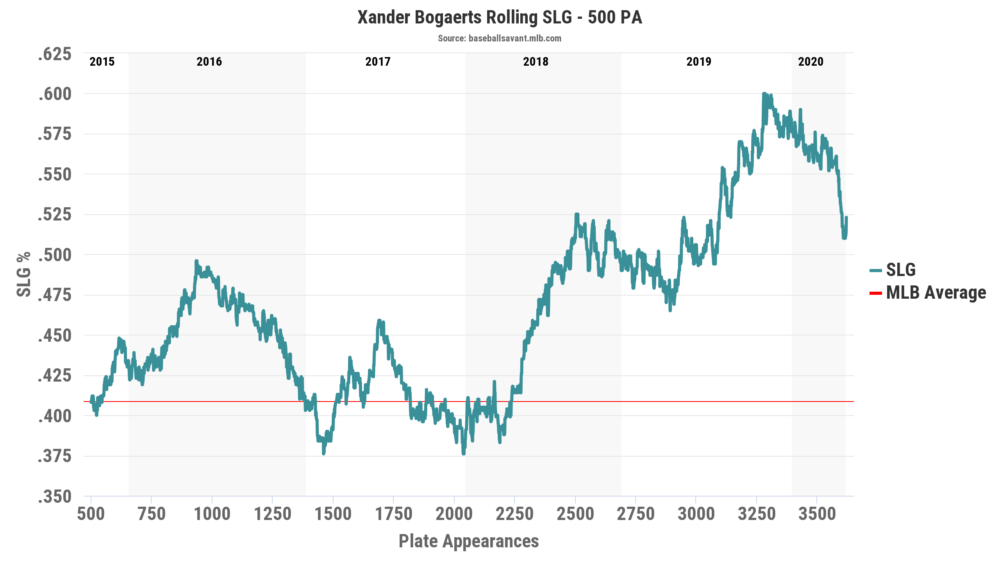
With out going into all of the particulars, Bogaerts broke out by being more aggressive on pitches early in the count and on pitches in the zone while also putting the ball in the air more often.
2020 was more of the same, which is a fairly good sign. While Statcast indicates he may have been rather fortunate with respect to batting average, I believe that had he played in a full 162-game season, he would have returned similar results as 2019. I’d also have been interested to see the stolen bases, as he had already swiped eight bags in just 56 games despite stealing only four in 155 games the year before.
With Bogaerts, you can feel very comfortable knowing you will get 25 or more home runs, a healthy serving of runs and RBI, and maybe even 10 stolen bases all while hitting for a plus batting average.
No. 6: Bo Bichette (Toronto Blue Jays)
Are you not entertained?! The highly-touted prospect has been electric in his first 75 major league games, hitting 16 home runs, stealing eight bases, and hitting .307/.347/.549. It’s also noteworthy that he’s managed a very reasonable strikeout rate, though he hasn’t taken many walks.
When reviewing young players like Bichette, I’m not necessarily concerned with how quickly they hit the ground running. It’s great when guys like Bichette have hot starts, but what’s even more important is how they respond to their first slump or two. Every player has peaks and valleys, and the best ones find ways to get out of their slumps quicker than others.
That’s why I found the following rolling chart so interesting. This one happens to be a double rolling chart of his actual wOBA and walk rate:
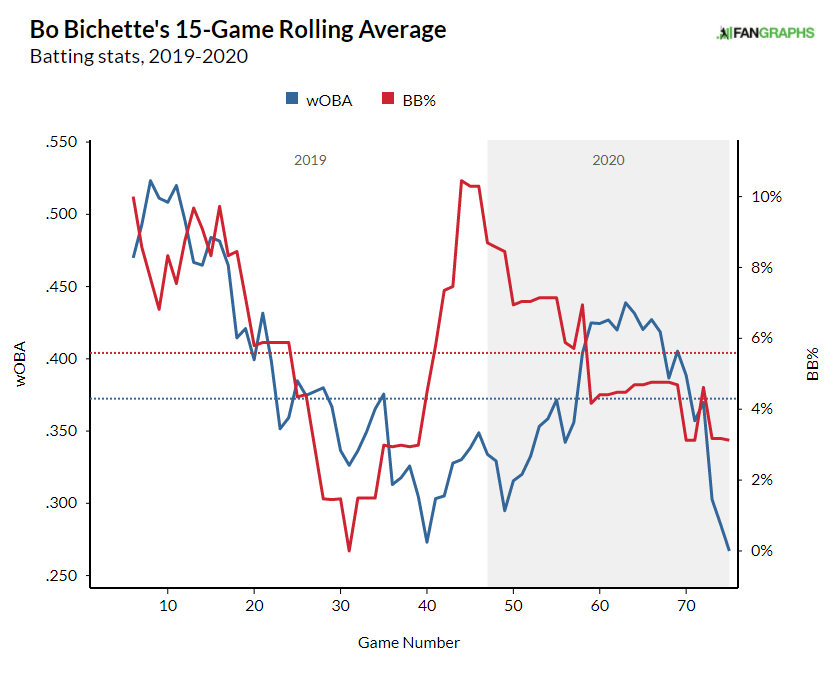
There are two key things you can learn from this chart. First, Fangraphs has this feature and will allow you to have multiple charts displayed at once. Second, and perhaps more relevant to the topic at hand, Bichette hit a bit of a lull with his bat, but during that time also became more patient.
I can’t pretend to know what Bichette and the hitting coach were talking about, but one thing I do know is that changes to approach like this can help players break slumps. Those types of adjustments in season, where a player shifts their approach over a very short period of time, can be indicative of growth, and while it doesn’t guarantee that he’ll always do this in the future, it’s a great sign that he can succeed long term.
I don’t expect him to be the next Joey Votto—Bichette’s 57% swing rate was 10th highest in baseball among the 267 hitters with at least 120 plate appearances, right behind fellow rookie star Luis Robert—but it’s promising to know that he can make that kind of adjustment when he’s struggling. Oh, and by the way, there’s nothing wrong with a high swing rate when you have the bat speed and hit tool of Bichette. If anything, we want him getting his bat on the ball, and it’s not like he’s missing all that much.
All in all, the future is extremely bright for Bo Bichette.
No. 7: Corey Seager (Los Angeles Dodgers)
Seager’s good-not-great 2019 is hard to fathom if you saw him in action last season. Seager’s 28 barrels in 2020 were just one shy of the 29 barrels he had in all of 2019 despite playing in 82 fewer games. His stellar quality of contact in 2020 has many projection systems envisioning a career year in 2021, pegging him for 30 home runs and close to 200 combined runs and RBI with a .280 batting average. I looked rather closely, and found the results to be quite legitimate—Seager is just a really good hitter.
Despite the excellent campaign and a lot of reasons to believe in him, I still find myself talking about what Seager doesn’t have as often as I talk about what he does have. Make no mistake, if your league doesn’t give much value to steals (such as a points league) or if you intentionally punt on stolen bases, Seager could very well be at the top of this tier; however, the reality of modern fantasy baseball is that steals are heavily weighted compared to other stats.
Seager is the first shortstop on this list that I don’t believe could steal 10 bases in 2021, and in most formats, that matters—especially when ranking a position that’s incredibly strong at the top. Despite being seventh on this list, Seager’s ADP is around pick 35 on the NFBC, and that’s seventh amongst shortstops. The first six? Their ADP is inside the top 25.
Seager makes for an excellent fantasy shortstop, though his complete lack of stolen bases is rather unique amongst the top three tiers at the position. If you don’t value stolen bases much, or if you’re in a points league, you can definitely consider pushing Seager up your board a few spots.
No. 8: Tim Anderson (Chicago White Sox)
It’s not easy to swing as often (or swing and miss as often) as Anderson does and post a batting average north of .300 with a strikeout rate below 25% for two consecutive seasons. How does he do it? Well, having excellent hand-eye coordination and top-notch speed helps a lot, but one thing stands out to me when digging into his profile—his improvement against breaking balls.
As is often discussed, breaking balls have become more common and more deadly throughout major league baseball. More and more pitchers are leaning heavily into their secondary pitches, with numerous notable cases where starting pitchers are throwing a breaking ball even more than their fastball.
As it turns out, it’s a very effective strategy for many pitchers, and as a whole, the league has an expected batting average of just .210 against breaking pitches (which Baseball Savant defines as sliders, curveballs, and the various off-shoots of a curve) and a .264 xwOBA. For reference, the league had a cumulative .260 xBA and .330 xwOBA against non-breaking balls..
Early in his career, Anderson was entirely ineffective against breaking pitches, but at some point, something clearly clicked for the speedy shortstop:
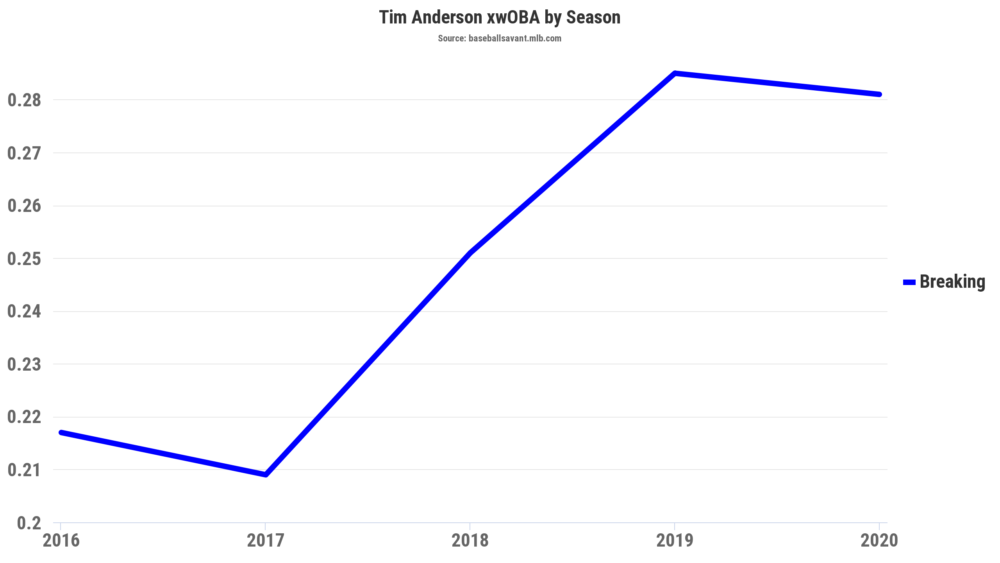
The improvement against breaking balls combined with his hyper-aggressive approach have turned Anderson into a 20-20 threat at the top of one of baseball’s most exciting offenses. Even with his high whiff rates and utter unwillingness to walk, as long as Anderson continues to be able to put the bat on the ball before getting the third strike, he should be a valuable addition to a fantasy roster.
As a final note, I do want to make sure I address Anderson’s BABIP, which sits at .395 since the start of 2019. Even for someone as fast as Anderson, that’s suspiciously high; however, don’t fall into the trap of just assuming it will “correct itself” back to .300. I believe the wiser approach would be to look at metrics such as xBA, which suggests that Anderson has been somewhat fortunate, but that he has also been a .290 hitter or better even without the good luck.
No. 9: Adalberto Mondesi (Kansas City Royals)
Let’s get one thing straight: Mondesi is not a very good hitter, at least not compared to his peers in the first five (or maybe even 6) tiers at this position.
Heading into September last season, Mondesi was batting a putrid .186/.211/.240, good for a wRC+ of 17. A wRC+ of 17 means he was 83% worse than the average hitter in that period. That wasn’t just the worst among qualified hitters, it was the worst by 31 points. Those 31 points between Mondesi and the second-worst hitter is the same gap between the third-worst and the 34th-worst hitters. It’s a chasm of awfulness.
But then September came. In September, Mondesi hit .356/.408/.667, good for a 187 wRC+. That was sixth-best in baseball, right ahead of a guy named Mike Trout. He also stole 16 bases that month, which is almost double what second-place finisher Trea Turner could muster.
Mondesi is obviously capable of dominating in fantasy baseball for certain periods of time. In 2020, 100 plate appearances of excellent baseball was enough to (mostly) wipe out just how terrible he was prior to that moment.
Here’s the issue—in head-to-head leagues, “making up for it” is not the same as it is in roto. In those formats, Mondesi certainly helped you in those final weeks, but because hitting only makes up for five categories and stolen bases are just one of them, the amount of lift he can provide is heavily capped. In roto, on the other hand, that single stretch could net you a huge boost in rankings points, assuming you weren’t already near the top in stolen bases.
In other words, Mondesi’s extreme volatility will help balance him out as a high-end fantasy player, but it can be difficult to manage a player like that, especially when they so dreadful during the cold spells.
If you are in a deep roto league, Mondesi is probably much higher on your board—and rightfully so, as his stolen base upside is unmatched, and if you just hold your nose and leave him in your lineup, the final line should be passable. It’s hard to argue with someone who sees that 20 home run, 60 stolen base potential and wants it for their roster.
Personally, I’d rather find a less stressful way to attack stolen bases, particularly in 10- and 12-team formats where I’m more likely to find ways to cobble together a workable stolen base floor.
Tier 4: Back-End Starters
No. 10: Gleyber Torres (New York Yankees)
If you just look at the final numbers, 2020 was a lost season for Torres. After hitting 38 home runs in 2019, he managed just three in 2020 to go along with a .243 batting average and .368 slugging percentage. That said, if you look just a little deeper, you can find two promising bits of data that suggest brighter days are head.
First, as you likely suspected if you’ve been reading these, let’s take a look at his rolling xwOBA in 2020:
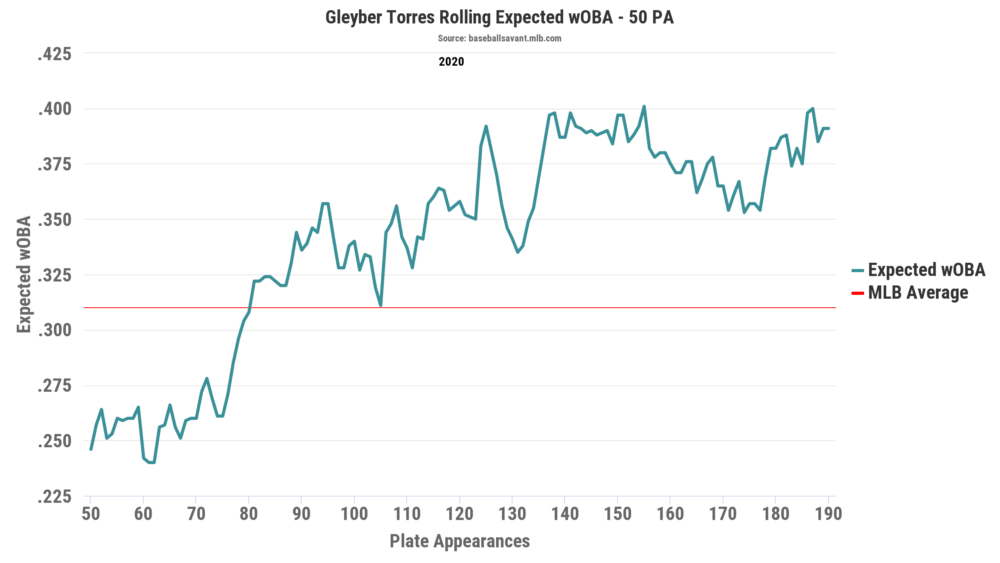
Obviously, the start was worrisome, but he did eventually make the necessary adjustments and finished the season quite strong. Had the season been its normal length, it’s possible that Torres could have salvaged it to some degree.
The other promising piece was his plate discipline: Torres walked considerably more (13.8% walk rate) and struck out considerably less (17.5% strikeout rate) than we’ve seen in the past. While he was never all that bad in either category previously, he went from average before 2020 to quite good in 2020.
Torres should be more than capable of clearing 30 home runs and a batting average at least in the .270 range, and hitting around the middle of the Yankees lineup should lead to a good number of counting stats. He falls just a bit short in track record and upside compared to the other shortstops on this list above him, but that doesn’t mean he’s not a good player—it just means the position is incredibly deep.
No. 11: Javier Báez (Chicago Cubs)
Many have looked at Báez and his obscenely aggressive approach and wondered if the bottom would eventually fall out, and in 2020 that’s essentially what happened. You’d think that it would have something to do with the increased percentage of breaking balls he saw in 2020, and perhaps it does to some degree, but the real shocker is that he struggled mightily against fastballs.
One of the key reasons Báez has been so successful despite swinging at almost everything he sees is that he has elite hand-eye coordination and is uber-athletic. Even when the pitch is well outside of his happy zone, he’s able to either fight it off or punch it just enough to give him a chance to reach first base. For this to work to the level it had prior to 2020, he has to really capitalize on pitches he can (and actually should) hit—namely, fastballs.
In 2020, that’s not what happened:
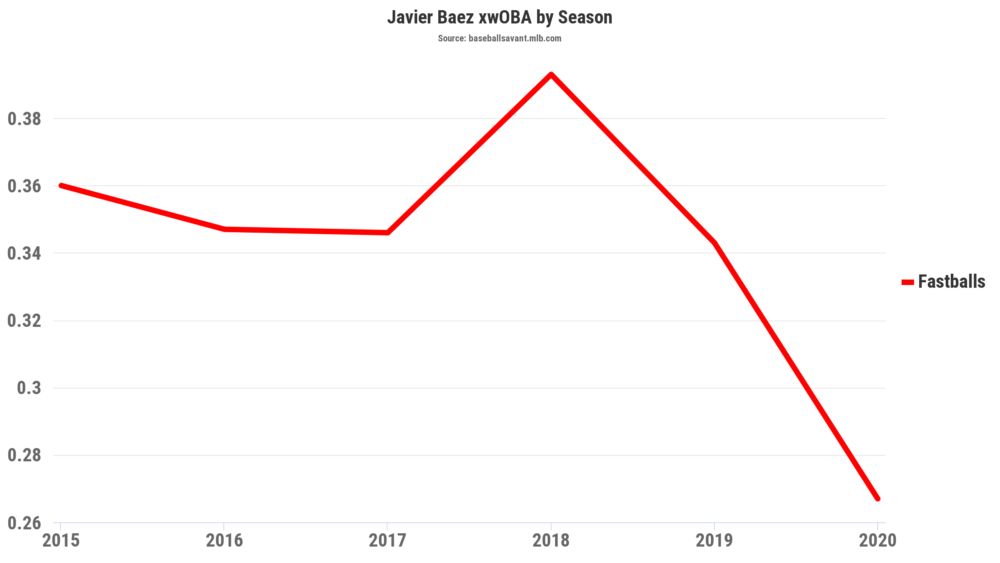
A Báez who can’t do damage to fastballs is a Báez who is more of a defense-first player than a fantasy starter. While there are a bevy of reasons why he struggled to his those pitches in 2020, we do know two things: he wasn’t chasing them more, and he wasn’t whiffing on them more. He was just hitting them poorly.
I believe Báez can get out of whatever funk he was in as we enter 2021, and if he does, the 30 home run upside with a strong batting average and double-digit stolen base totals makes him a huge bargain at where he is being selected in drafts. Unfortunately, we can’t rank him much higher than this when we’ve seen how low the floor can get, especially when compared to his peers.
No. 12: Carlos Correa (Houston Astros)
Sure, the 2020 regular season was bad as he hit just five home runs with a .383 slugging through 58 games, but did you see him in October?
In 13 playoff games, Correa showed us why we’ve been so patient waiting from him to put health and performance together for a full season. He hit six home runs (yes, that’s more than he did in the regular season) and had an astonishing 1.221 OPS.
That’s really the long and short of it with Correa—he can be absolute dynamite when he plays, but he missed huge chunks of the season in 2017, 2018, and 2019. It’s hard to project Correa at this point, as the repeated injuries have likely impacted his upside, but considering he’s only 26, it’s OK to be excited about the upside of 30 home runs, 100 RBI, and a .275 batting average.
I wish I had more to say about Correa, but truthfully, all that really matters is whether he can stay healthy and play ball.
No. 13: Marcus Semien (Toronto Blue Jays)
Despite a .223 batting average in 2020, Semien still showed off the improved walk rate he had in 2019 along with decent power and speed. While I would have really loved to see him also keep up with the 13.7% strikeout rate, it just wasn’t in the cards.
Regardless, it’s hard to put into words how great everything was in 2019. He truly looked like a brand new player…until he didn’t anymore.
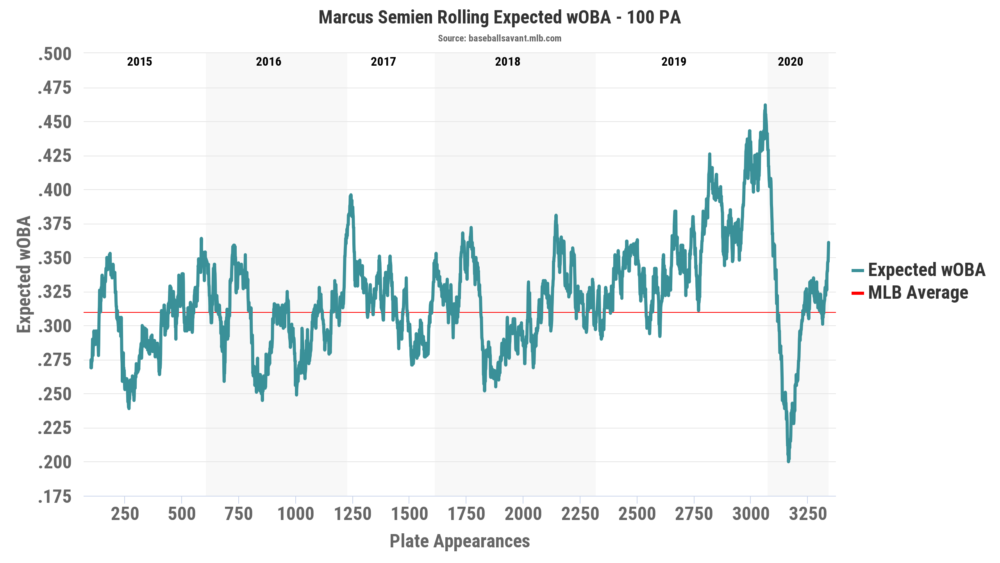
For the time being, Semien looks locked in towards the top of the Blue Jays lineup, so his 20-25 home run potential should come with plenty of counting stats and maybe even double-digit stolen base totals. There’s also a chance, though, that he just can’t get on base quite enough to justify having him bat second instead of Biggio or one of the other talented Blue Jays.
No. 14: Dansby Swanson (Atlanta)
Swanson didn’t really draw much interest for shallow league players until 2019 due to his very limited power and speed upside together with a sub-par batting average. Something changed in 2019, though, which completely raised his floor.
All players in baseball go through slumps hot streaks—it’s just part of the game. One essential aspect to long term success in the major leagues is how quickly you can stop the slump and turn it back around. Early in his career, Swanson could sustain a hot streak for a while, but his cold spells were brutal, making him a below-average shortstop for fantasy.
As you can see in the chart below, though, Swanson was able to find a new floor for himself, one that was much more palatable than his previous lows while also finding new highs:
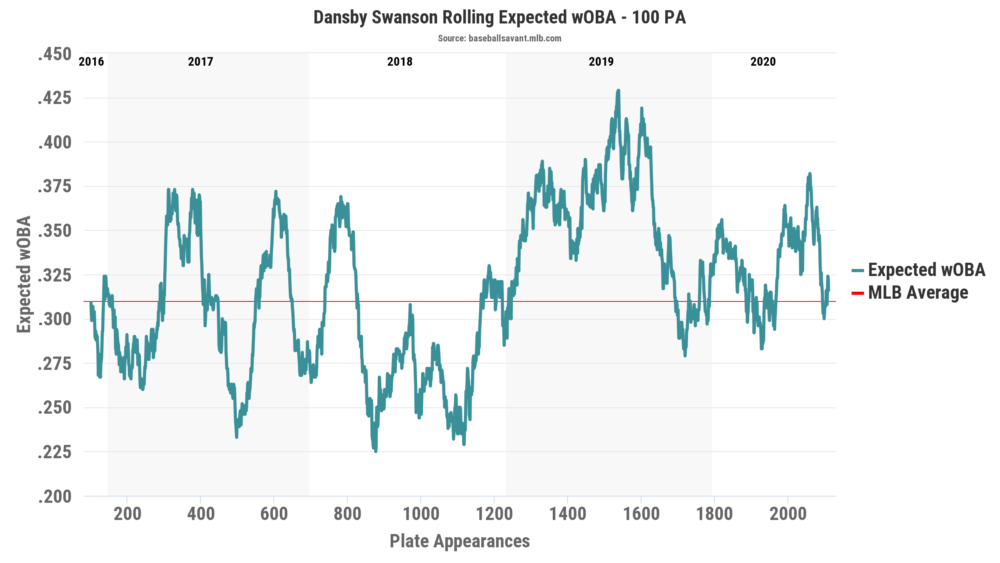
While this new version of Dansby Swanson isn’t a world-beater by any means, he could very well be a 25 home run, 12 stolen base guy who hits closer to .265 than .245, and that’s just enough to be a back-end starter. His ceiling probably isn’t high enough to put him at the top of this tier, but his new floor should be high enough to keep him on the list. It’s not flashy, but it’s honest work.
Tier 5: Deep League Options
No. 15: Didi Gregorius (Philadelphia Phillies)
A return to Philly may have been the best case scenario for Didi’s fantasy outlook. While he has shown home run pop over the last few years, it has been largely tied to the fact that he’s played in parks (Yankee Stadium and Citizens Bank Park) that are very generous to left-handed hitters, particularly with respect to home runs. Didi was actually in the bottom three percent in average exit velocity in 2020, with balls leaving his bat at a pedestrian 83.8 miles-per-hour, but when he finds pitches he likes he’s got just enough to pull it right over the fence in right field.
That being said, there’s a very safe floor here that comes with batting in an above-average lineup in a home park that’s well-suited to his bat. He doesn’t have more than five to seven steals in him, and I’d be surprised if he hit more than 25-27 home runs, but that’s not too bad when you couple it with a very high floor.
Didi is best utilized in deeper leagues and those with a middle infield spot to lock up the position and provide stability. He’s also got a little extra value in points leagues due to his low strikeout rates and how often he puts the ball in play. He probably won’t wow you, but you’ll know what you’re getting in Didi, and that’s not too bad when stacked against the rest of the list.
No. 16: Tommy Edman (St. Louis Cardinals)
I am admittedly unsure of what to make of Edman. On one hand, his 147 major league games as a whole are quite impressive—88 runs scored, 16 home runs, 17 steals, and a .283/.337/.449 line. Unfortunately, it’s not exactly a case of balanced production.
After exploding onto the scene as an almost entirely unheralded prospect, Edman has been mostly average except for a few bursts at the start and end of his 2019 campaign and a little bit at the start of 2020.
While I suppose you could talk yourself into a 20 home run, 20 stolen base season by squinting a little and focusing on 2019, you can just as easily see the downside of a 15 home run, six stolen base season with a mediocre batting average.
The latter is not useful in a shallow league, I’m afraid, and while his ceiling is a decent piece to a 2021 puzzle, I’d be looking for more upside in a 10- or 12-team league.
On the other hand, deep-league players will find value in his versatility that makes chasing the upside a bit more tantalizing. Edman is a classic example of a player whose value changes drastically when more teams and roster positions are added and his positional eligibility and stolen bases really shine.
Tier 6: Even Deeper League Options
No. 17: Chris Taylor (Los Angeles Dodgers)
The Dodgers just love the flexibility Chris Taylor brings to their team, and while it has played well for real baseball, the results have been spotty for fantasy purposes. After a very strong 2017 season, it’s been hard for fantasy managers to find room on their rosters for Taylor, as he has just low enough power, contact, and speed upside to usually find yourself looking elsewhere on the waiver wire.
Projection systems all have Taylor playing a full-time role for the Dodgers as he did in 2020, but it doesn’t take much to see that role evaporate into a first-off-the-bench scenario, especially with Lux right on his heels for the second base job.
Even a DH doesn’t necessarily clear up the air, as the Dodgers have plenty of other hitters who they’d probably like to slide in, especially against right-handed pitching. Between the capped upside and the fact he’s batting ninth, Taylor is mostly restricted to deep leagues where his versatility is more of an asset.
No. 18: Andrés Giménez (Cleveland)
The signing of Cesar Hernandez sort of mucks things up for Giménez, who was previously slated to bat at the top of the order.
On one hand, Giménez has just enough speed and contact ability to be dangerous and could pop double-digit home runs with 25 steals and acceptable ratios. On the other hand, all of that comes down a bit if he’s batting in the bottom third of the lineup for a team that is not nearly as formidable offensively as they were in years past.
There’s also a non-zero chance that Giménez is forced to platoon at times with Amed Rosario when facing tougher left-handed pitching. The path to reaching his ceiling grows foggier every day, and when the upside was already a fringe starter in standard leagues, it becomes tough to make Giménez a draft-day target. As of March 8, this is becoming more and more worrisome as a possibility.
Of course, as with most speedsters, deep-league managers will want to slide Giménez up their boards if they are still looking for steals later on in the draft, and his eligibility at second, shortstop, and third provides wide infield coverage.
I’m willing to put Giménez back in the previous tier if Rosario is traded or Giménez wins the job outright. Until then, though, I’m too scared to count on him in a 10- or 12-teamer.
No. 19: Jake Cronenworth (San Diego Padres)
Statcast loved his game in 2020, and it’s hard to forget how amazing he was when he debuted for the Padres. What might have been lost in the short season, though, was that he was not consistently as awesome as you might have thought for those 54 games he played in the regular season:
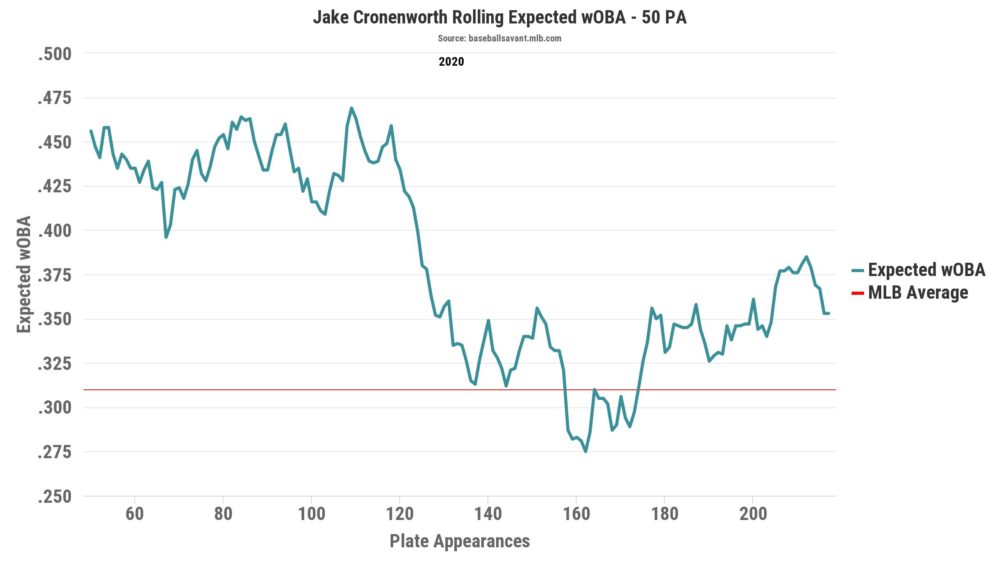
Now I don’t want you to think that I’m saying Cronenworth is a bad player—he seemed to adjust over time as pitchers gave him new looks, and seeing rookies rebound after they hit a bit of a valley is a very good sign.
The real issue for Cronenworth will be finding plate appearances. There are no fewer than four players on the Padres projected opening day roster who can play second base, and three of them are actually on this list (sorry, Jorge Mateo).
I can’t exactly envision a clear path to 120 games, and because of that, it’s also tough to see more than 10 home runs or steals. If you guaranteed me a full season of plate appearances, Cronenworth likely finds himself in the fourth or fifth tier.
You can’t do that, though, so I guess this is where we have to land for now.
No. 20: Kim Ha-seong (San Diego Padres)
Fun Fact—in Korea, you would refer to someone by their surname first, then their personal name (or, in Western terms, their last name first and their first name last). My grandfather, for example, was known as Chu Myung-Il in Korea, but it was flipped to Myung-Il Chu when he came to the US. The hyphenated name is a continuation of the personal name, not a middle name.
Much like with his teammate Cronenworth, this ranking changes considerably if you tell me he’s going to play 140 games. In that scenario, I could see 15 home runs, 15 steals, and meaningful runs scored and RBI totals due to the potency of the Padres lineup.
While it can be difficult to project players coming from the soft-tossing, contact-oriented KBO, the 25-year-old Kim should have enough speed, power, and hitting ability to be a solid major leaguer once he gets the chance to play every day.
Unfortunately, it doesn’t appear 2021 will provide that opportunity. He should have some nice value in dynasty formats, though, and is a popular pick early in first-year player drafts.
No. 21: David Fletcher (Los Angeles Angels)
I love Fletcher, and that’s why he’s so high up in these rankings. Sure, he probably won’t get 10 home runs or 10 steals, but he’ll hit close to .300 and it’s not hard to envision 90 or more runs scored when he’s leading off for a top-heavy offense.
In virtually all formats, you should be able to slot Fletcher in at second, shortstop, or third base, and he’ll provide elite batting average and strong runs scored, although not a whole lot else. He’ll be rostered at some point in your 12-team leagues because of injuries or because he’s a bit hot, and points league players will probably even draft him as their last hitter due to how often he puts the ball in play.
His positional versatility is quite an asset when you have tight benches. You probably don’t want him as your starter for a full season, though, unless you’re in a 15-team format that uses middle and corner infield spots.
No. 22: Jorge Polanco (Minnesota Twins)
Either he or Luis Arraez is going to be a super-utilityman who bats near the top of the order most of the time. Or maybe both of them will be? Or neither?
That’s really the issue with Polanco heading into 2020. The Twins have more good bats than they do spots to put them, and that means one of Polanco or Arraez is going to get squeezed out of a regular role. Early reports do peg him as the second baseman for 2021, but at the very least it will be a competition in the spring against Arraez, who makes more contact than just about anyone in the league.
2019 really highlighted Polanco’s upside as a 20 home run bat with a strong average who can score 100 runs and steal a handful of bases near the top of the order. He needs plenty of playing time to do that, though, and it’s hard to feel overly confident about whether he’ll actually get that.
No. 23: Amed Rosario (Cleveland)
There is a non-zero chance that Rosario could hit 15 home runs, steal 19 bases, and bat above .270 like he did in 2019. I mean, it could happen.
It’s just really unlikely. Not only did Rosario disappoint offensively in 2020 by hitting just four home runs and not stealing a single base, he was recently traded to a team who appear to have three middle infielders and only two spots to play them.
My best guess is that Rosario makes it into the lineup every time Cleveland faces a lefty and also whenever someone needs a day off by shifting a few folks around and giving them off days. Unless he outright takes the job from Cesar Hernandez, though, it’s hard to see Rosario playing in more than 100 games.
Even though he could still reach double-digit steals and home runs in that time frame, shallow league players can’t really afford to hold a guy like Rosario on their bench unless there are 10 or more spaces, and then then, I bet there’s something better out there.
One final note—if Rosario can be traded to the Reds, he would move up several spots on this list. That’s really the ideal landing spot for him and I hope it can get done.
3/26 Update: He could also find time in the outfield with Mercado being demoted, so I’ve moved him up.
No. 24: Willi Castro (Detroit Tigers)
I don’t usually use these percentile rankings from Statcast to make a point, as generally speaking, a lot of the stats are redundant. If you have a high exit velocity, you’re going to have a high Hard Hit rate. If you have a high xwOBA or barrel rate, you’re going to have a high expected batting average and expected slugging percentage. It just doesn’t always provide a variety of information.
And then there’s Castro, who has percentile rankings that befuddle and perplex me:
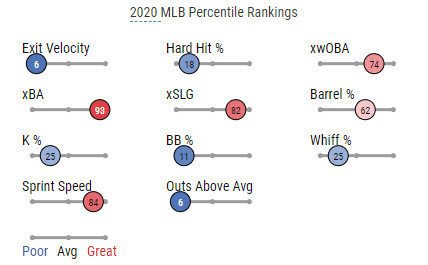
It’s pretty weird to see such poor exit velocity numbers and such high expected stats and a good barrel rate, but here we are. I kept wondering if I had ever seen this before, and then I realized that I had—Luis Arraez. Arraez has similar career numbers in that he has very low exit velocity but a decent barrel rate and expected stats.
Both hitters hit a lot of grounders and line drives and few fly balls, and generate a ton of singles by getting between the infielders and outfielders. That’s not going to be enough to clear the fences all that often, though, unless you sell out a bit for power when you think you have a good pitch.
Arraez really doesn’t do that, though, and that’s why he never seems to strike out or walk. Castro does sell out, and then proceeds to sometimes hit home runs and also strike out. Unfortunately, because he doesn’t have much stolen base prowess and is extremely risky due to his aggressive approach and limited experience, he’s more of a flyer for me than anything else.
3/26 Update: A hot spring has me feeling like 2020 might not be an aberration.
Tier 7: Dart Throws and Bench Guys
No. 25: Wander Franco (Tampa Bay Rays)
I do not expect Franco to make an appearance in the major leagues in 2021; however, when it comes to watch list candidates and last roster spots, we care a whole lot more about upside than we do current playing time in a 10- or 12-teamer.
Deep league players need to push Franco down their board—in fact, he’s probably not even top-30 due to how much playing time impacts value in those formats.
Regardless of league format, though, we can all agree that there are very few players in after tier three who have the ability to jump into tier two—Franco is one of them.
No. 26: Paul DeJong (St. Louis Cardinals)
If you’re in a deep league, feel free to bump DeJong closer to the middle of the previous tier. In a shallow league, though, I just don’t have enough faith that DeJong can be a productive player.
While DeJong does have 26 home runs in his last 162 games, he’s also hitting .214/.292/.387 with an uninspiring 78 runs scored and 84 RBI. That batting average is a hard pill to swallow with such average stats and very little speed, he just can’t move the needle in a 10- or 12-team league.
No. 27: Jonathan Villar (New York Mets)
We all promised we wouldn’t be fooled again, and then many of us were anyway. Villar struggled to hit for any kind of power in 2020, though his 16 stolen bases were second in all of baseball. Much of Villar’s value is going to be tied to how much he actually ends up playing. Villar is fast, but he’s far from a good defender so he’ll need to either get hot (which he certainly can do) or wait for a player to be ineffective or inactive to get in.
Still, his 20 home run and 40 stolen base upside is incredibly hard to pass up. Of course, we know his floor is much lower than that, and landing with the Mets makes his odds of reaching that potential a bit longer than they may have been elsewhere.
Keep in mind that in deeper leagues that use a middle infielder spot, Villar should probably drop even further. With both performance and playing time being a potential issue, he just can’t be trusted in any kind of starting spot right now.
No. 28: Willy Adames (Tampa Bay Rays)
He’ll play a lot, get close to 20 home runs, and steal six or seven bases with a .260 batting average. It’d be cooler if he didn’t bat ninth, though, as it really drags down his counting numbers to the point where I doubt he’ll get to 70 in either runs or RBI.
That’s probably the ceiling and the floor, though I should point out that in 2020 we saw a slight uptick in power and a sharper uptick in strikeouts. I’m not reading much into it at the moment, as it sort of seems like a classic play of selling out for power, and it’s hard to determine whether that will be a long term approach.
As with a lot of other players at this point in the rankings, he’s much more useful in a 15-teamer or AL-only league where the fact he plays all the time has value.
No. 29: Elvis Andrus (Oakland Athletics)
After 32 years on this earth and appearing in 1,652 games since he debuted in 2009, Andrus is finally starting to slow down. Without the stolen bases, there just isn’t enough here to get overly excited about.
That is, unless he leads off in Oakland. He’s probably not the favorite for the job, but with no clear candidates and an open competition, it’s not an unrealistic outcome. In that scenario, he’s much more interesting on a scrappy Athletics team that will need to steal bases at times to score runs.
No. 30: Jazz Chisholm (Miami Marlins)
If he played a full season, he could very well hit 20-25 home runs and steal 15-20 bases. There are just two issues with that scenario:
First, he’s really not likely to play more than 80 games. If I had to bet, I’d take the under on 60.
Second, even if he proved me wrong and played, I’d bet that he’d hit under .200.
He’s on this list because of that speed and power upside that’s worth being placed on your watch list, and also because he was more exciting to list than any of the honorable mentions.
3/26 Update: It looks like he might have the inside track to a large chunk of the playing time, which is cool, but I’m not moving him up.
Honorable Mentions
Nick Ahmed (Arizona Diamondbacks)
The definition of deep league replacement level. A home run total in the high teens, just under double-digit steals, a .250 batting average, and 70ish runs and RBI. That’s the ceiling.
There’s nothing wrong with that, and he’s a very solid add in an NL-only format. There’s just really no appeal in a 12-teamer, though, unless he has a road series in Coors or faces a string of soft lefties, as he’s got a career line of .281/.331/.467 against them in his career.
Mauricio Dubón (San Francisco Giants)
He can play a lot of positions and has 15 home run, 15 stolen base upside if you squint hard enough. Unfortunately, I doubt he plays more than 100 games or so, which puts him well off the 10- and 12-team radar.
J.P. Crawford (Seattle Mariners)
There will probably be a three week period or so where he looks like a top option on your waiver wire, but the former first rounder just can’t hit enough to be viable in all but the deepest of formats.
Isiah Kiner-Falefa (Texas Rangers)
He is only interesting in mixed leagues as a catcher, where he still qualifies in Yahoo leagues. His positional eligibility, while unique, is meaningless unless he can be slotted at catcher or if you’re in an AL-only league.
José Iglesias (Los Angeles Angels)
If you’re in a super deep league, Iglesias should play just about every day and make plenty of contact. His ceiling is probably about 10 home runs, 10 steals, and a .300 batting average, which would be just good enough to crack the last tier. But that’s his ceiling.
Nico Hoerner (Chicago Cubs)
He’s mostly just a contact hitter with a little bit of speed, a little bit of pop, and plenty of playing time at the bottom of the Cubs’ batting order. That plays in NL-only leagues, but not mixed.
**Trivia Answer: Ronald Acuña Jr. (2019), Christian Yelich (2019), and Ryan Braun (2012)
Photos by Quinn Harris & Andrew Dieb/Icon Sportswire | Adapted by Justin Redler (@reldernitsuj on Twitter)
